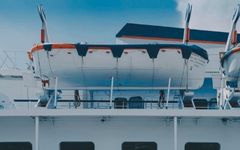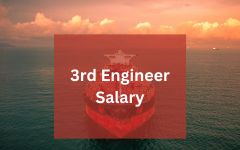Inland Marine Insurance - What is it & Top 5 Reasons You Need It
Inland Marine Insurance is a type of insurance policy that covers movable or transportable assets, including goods, equipment, and other property that are transported over land, as opposed to “marine insurance,” which covers products when transported over water. Most of losses covered by inland marine insurance are caused by collisions and cargo theft.
Inland Marine Insurance is designed to protect property while it is in transit or temporarily located away from the owner's premises. It is also commonly known as "Goods in Transit Insurance" or "Floater Insurance."
In today's business landscape, protecting your movable and transportable property is crucial. That's where inland marine insurance comes in - this type of policy provides comprehensive coverage for goods in transit or stored away from your premises. Businesses that frequently transport or store valuable property, such as trucking companies, freight carriers, art galleries, museums, and storage facilities, simply cannot afford to be without this essential insurance. With inland marine insurance, you can rest assured that your property is protected from any potential damages or losses that may occur during transportation or storage. Don't take any chances when it comes to safeguarding your valuable property - consider investing in inland marine insurance today.
Inland marine insurance policies can vary in coverage, so it's important to understand what your policy includes and excludes. Typically, inland marine insurance policies cover property in transit or storage, but may also provide coverage for property on display or in exhibitions. Some policies may also include coverage for property that is temporarily in the possession of others, such as goods being repaired or serviced.
Key Benefits of Inland Marine Insurance
One of the key benefits of inland marine insurance is that it can provide coverage for property that is not covered under other types of insurance policies. For example, if a trucking company's cargo is damaged in transit, their standard commercial property insurance policy may not cover the loss. Inland marine insurance can fill this gap in coverage and provide protection for the cargo.
Protection for Movable Property
Inland marine insurance provides coverage for movable property, including goods in transit and those stored away from your premises. This type of policy is designed to protect your property from damage, loss, or theft that may occur during transportation or storage. With inland marine insurance, you can have peace of mind knowing that your property is protected no matter where it is.
Flexible Coverage Options
One of the great things about inland marine insurance is that it offers flexible coverage options to suit the unique needs of your business. Whether you're a trucking company, freight carrier, art gallery, museum, or storage facility, you can customize your policy to cover your specific property and risks.
Liability Protection
However, not all inland insurance policies offer the same level of protection. In recent years, there has been an increased focus on liability protection in inland insurance policies. In this article, we'll explore what liability protection is, why it's important, and how you can ensure that your inland insurance policy provides adequate coverage.
- What is Liability Protection?
Liability protection is a type of insurance coverage that protects you from financial losses that arise from legal claims made against you or your business. Liability claims can arise from a variety of sources, including accidents, injuries, property damage, or even wrongful death. Liability protection provides coverage for legal fees, settlements, and judgments that you may be required to pay if you are found to be at fault in a liability claim.
- Why is Liability Protection Important in Inland Insurance?
Inland insurance policies typically provide coverage for damage to property and goods during transportation. However, if damage occurs due to negligence or fault on the part of the transportation provider, the provider may be held liable for damages. Liability protection in inland insurance policies helps to ensure that transportation providers are adequately covered in the event of a liability claim.
In addition, liability protection is important for businesses that transport their own goods or use their own vehicles for transportation. If an accident occurs and the business is found to be at fault, the business may be held liable for damages. Liability protection in inland insurance policies can help to protect businesses from financial losses resulting from liability claims.
Coverage for New Risks
As your business grows and evolves, so do the risks you face. Inland marine insurance can provide coverage for new risks that may arise as you expand your operations. For example, if you start offering a new service that involves transporting delicate artwork, you can add coverage for that specific risk to your inland marine insurance policy.
Cost-Effective Protection
While the cost of inland marine insurance may vary depending on your business's unique needs, it can be a cost-effective way to protect your movable property.
When selecting an inland marine insurance policy, it's important to work with a knowledgeable insurance agent who can help you understand your coverage options and select the policy that best meets your needs. It's also important to review your policy regularly to ensure that your coverage remains appropriate for your business needs
Inland Marine Insurance is a specialized type of insurance that covers property that is typically not covered by other insurance policies. Inland marine insurance policies are often tailored to the specific needs of a business or individual, and they can provide coverage for a wide range of property types.
It covers property that is transported over land, such as equipment, merchandise, and other goods. It is also known as "equipment insurance" or "floating equipment insurance." But, what kind of equipment is insured in Inland Marine Insurance contracts? Let's explore.
Transportation Equipment & Inland Marine Insurance
Transportation equipment is one of the most critical assets for businesses that rely on the transportation of goods or people. Such equipment is exposed to various risks such as accidents, theft, and damage, especially when in transit. For this reason, many businesses that depend on transportation equipment often opt for inland marine insurance to mitigate the financial losses resulting from these risks.
Inland marine insurance can provide coverage for various types of transportation equipment, including trucks, trailers, buses, and other types of vehicles. This coverage includes protection against damage or loss to the equipment, as well as liability coverage in the event of an accident.
Trucks are a common type of transportation equipment that can be insured under an inland marine insurance policy. These vehicles are often used to transport goods over long distances and are therefore exposed to various risks such as accidents, theft, and damage. Inland marine insurance can provide coverage for these risks, including coverage for physical damage to the truck, liability coverage for damages caused by the truck to third parties, and coverage for theft or hijacking of the truck or its cargo.
Trailers are another type of transportation equipment that can be insured under an inland marine insurance policy. These trailers are often used to transport goods over long distances and are exposed to various risks such as theft, damage, and accidents. Inland marine insurance can provide coverage for these risks, including coverage for physical damage to the trailer, liability coverage for damages caused by the trailer to third parties, and coverage for theft or hijacking of the trailer or its cargo.
Buses are also a type of transportation equipment that can be insured under an inland marine insurance policy. These vehicles are often used to transport people over long distances and are therefore exposed to various risks such as accidents, theft, and damage. Inland marine insurance can provide coverage for these risks, including coverage for physical damage to the bus, liability coverage for damages caused by the bus to third parties, and coverage for theft or hijacking of the bus or its cargo.
In addition to these types of transportation equipment, other types of vehicles can also be insured under an inland marine insurance policy. These include specialized vehicles such as mobile cranes, armored vehicles, and other types of specialized equipment used for transportation purposes. Inland marine insurance can provide coverage for these types of equipment, including coverage for physical damage, liability coverage, and coverage for theft or hijacking.
When considering inland marine insurance for transportation equipment, it is important to note that the coverage provided may vary depending on the type of equipment, the value of the equipment, and the risks associated with the transportation. Therefore, it is essential to work with an experienced insurance provider who can assess your specific needs and tailor coverage that meets your business's requirements.
Construction Equipment
One of the most common types of property insured under inland marine insurance policies. This type of equipment can be quite expensive, and it is often transported to job sites where it may be subject to damage or theft. Inland marine insurance can provide coverage for a wide range of construction equipment, including bulldozers, backhoes, cranes, and more.
Inland Marine Insurance covers construction equipment, such as cranes, bulldozers, excavators, and backhoes. These are expensive pieces of equipment that are often used on job sites, which makes them vulnerable to theft, vandalism, and damage.
Medical Equipment
This includes equipment used in hospitals, clinics, and other medical facilities, as well as equipment used by healthcare professionals who travel to different locations to provide care. Inland marine insurance can provide coverage for this equipment, protecting against loss or damage during transit. These machines are critical for the diagnosis and treatment of patients, and they are often transported between medical facilities.
Communication Equipment
Communication equipment, such as telephone and radio equipment, is also covered by Inland Marine Insurance. This type of equipment is often used by businesses and emergency services, and it is critical for maintaining communication channels.
Electronic Equipment
These items are often transported between offices, and they are vulnerable to damage and theft. This includes computers, servers, and other types of electronic equipment that are often transported from one location to another. Inland marine insurance can provide coverage for this equipment, protecting against loss or damage during transit.
Musical Instruments
Musical instruments, such as pianos, guitars, and drums, are also covered by Inland Marine Insurance. Musicians often transport their instruments to gigs and performances, and Inland Marine Insurance can provide peace of mind in case of damage or theft.
Fine Art and Antiques
Fine art is another type of property that can be insured under inland marine insurance. Art collectors and galleries often transport valuable artwork from one location to another, and this artwork can be subject to damage or theft during transit. Inland marine insurance can provide coverage for this type of property, helping to protect against financial loss due to damage, theft, or other covered risks.
Jewelry
Inland Marine Insurance covers jewelry, such as engagement rings, necklaces, and bracelets. These items are often transported between stores and customers, and they are vulnerable to theft and damage.
Other Equipment
Inland Marine Insurance also covers other types of equipment, such as sporting equipment, livestock, and even airplanes. It is important to note that the coverage provided by Inland Marine Insurance can vary depending on the policy and the insurer. Some policies may exclude certain types of equipment, while others may offer broader coverage.
Top 5 Reasons Why You Need Inland Marine Insurance
1. Protection for Assets, Goods, or Property in Transit
If your business regularly transports equipment, tools, or products from one location to another, Inland Marine Insurance is essential. This type of insurance provides coverage for the property being transported, including damage or loss due to accidents, theft, or other unforeseen events.
For example, imagine that your construction company regularly transports expensive tools and equipment from one job site to another. If your tools are damaged or stolen during transit, Inland Marine Insurance can help cover the cost of replacing or repairing them, minimizing the impact on your bottom line.
2. Coverage for Off-Site Goods
In addition to property in transit, Inland Marine Insurance can also cover property that is stored off-site. This can include equipment or products that are stored in a warehouse or at a job site, for example.
If your business stores valuable property off-site, you may be at risk of theft, damage, or other losses. Inland Marine Insurance can help protect your assets, providing coverage for losses that occur while the property is stored away from your primary business location
3. Coverage for Unique or High-Value Assets
Inland Marine Insurance can be particularly valuable if your business owns unique or high-value goods that may not be fully covered by other types of insurance.
For example, if you run an art gallery, you may have valuable pieces of art that are not covered under a standard commercial property insurance policy. Inland Marine Insurance can provide additional coverage for these types of assets, helping to protect your business from significant financial losses in the event of damage, loss, or theft.
4. Flexibility to Customize Coverage
One of the benefits of Inland Marine Insurance is its flexibility. This is one of the main benefits of this type of insurance, as it allows you to tailor your coverage to match the value of your assets and your level of risk.
One way that Inland Marine Insurance can be customized is by insuring specific pieces of equipment or products. This approach can be particularly useful if you have high-value assets that require additional protection. For example, if you own a mobile medical clinic, you may have expensive medical equipment that you transport from one location to another. By ensuring these assets specifically, you can ensure that they are fully covered in the event of damage, loss, or theft.
Another option is to opt for blanket coverage that provides protection for all of your movable assets. This approach can be more cost-effective, as it allows you to insure all of your assets under a single policy. This can be particularly useful for businesses that have a large number of movable assets, as it can simplify the insurance process and help ensure that all of your assets are adequately protected.
In addition to customizing the specific assets covered under your policy, you can also adjust your coverage limits to match the value of your assets and your level of risk. This allows you to ensure that you have enough coverage to protect your assets in the event of a loss, without paying for more coverage than you need.
For example, if you own a small landscaping business with a few pieces of equipment, you may choose to set your coverage limit at a lower level. However, if you operate a large construction company with a fleet of trucks and heavy machinery, you may need a higher coverage limit to adequately protect your assets.
5. Peace of Mind
Finally, Inland Marine Insurance provides peace of mind for business owners. Knowing that your movable property is protected can help you focus on growing your business, rather than worrying about the potential financial impact of unexpected losses.
In addition, many Inland Marine Insurance policies provide additional services, such as risk management and loss prevention advice. These services can help you identify potential risks and take steps to minimize them, reducing the likelihood of losses in the first place.
Inland Marine Insurance & Weather Anomalies
Weather anomalies are unusual or unexpected weather events that can cause damage to property. Examples of weather anomalies include hurricanes, tornadoes, hailstorms, and floods. These types of events can be unpredictable and can occur anywhere, causing damage to goods that are in transit or stored in temporary locations. As a result, it's essential to understand what types of weather events are covered by Inland Marine insurance and what types of coverage are available.
What Happens in the Event of a Tsunami?
When it comes to weather-related events, including tsunamis, the coverage provided by Inland Marine Insurance can be limited. In general, a standard Inland Marine Insurance policy may not specifically cover losses caused by a tsunami. However, coverage may be available under certain circumstances, depending on the specific policy and the location of the insured property.
One option for businesses in coastal areas is to purchase separate flood insurance that specifically includes coverage for tsunamis. This type of coverage is typically sold as an endorsement to a commercial property insurance policy, and it may be available through the National Flood Insurance Program (may be USA specific) or a private insurance carrier.
Another way to obtain coverage for tsunamis is through a standalone Inland Marine Insurance policy that specifically includes coverage for earthquake and tsunami damage. This type of policy is typically only available in areas where there is a significant risk of seismic activity, such as California, Oregon, and Washington.
It's important to note that the cost of insurance coverage for tsunamis can be significant, particularly in areas with a high risk of seismic activity. Businesses in these areas should carefully evaluate the potential risks and costs of coverage and work with an experienced insurance professional to determine the appropriate coverage for their needs.
In addition to insurance coverage, there are several steps businesses can take to prepare for a tsunami and minimize the potential for loss. These include developing an emergency response plan, securing movable property, and storing critical documents and data in a secure, off-site location. (hurricane, flood, tsunami)
In addition to insurance coverage, there are several steps businesses can take to prepare for a tsunami and minimize the potential for loss. These include developing an emergency response plan, securing movable property, and storing critical documents and data in a secure, off-site location. (hurricane, flood, tsunami)
What Happens in the Event of Flood?
Flooding is a common risk faced by businesses that have movable property located in low-lying areas or in regions with high rainfall. Inland Marine Insurance can provide additional coverage for losses caused by floods and other water-related damage, but the extent of coverage can vary depending on the specific policy and the type of damage incurred.
In general, Inland Marine Insurance policies will cover losses caused by external factors such as flooding, storms, or water damage resulting from broken pipes or sprinkler systems. However, coverage may be limited depending on the cause and extent of the damage.
For example, some Inland Marine Insurance policies may exclude losses caused by water damage resulting from a backup of sewers or drains. In addition, coverage for flood-related losses may be limited by the policy's coverage limits and deductibles.
To obtain more comprehensive coverage for flood-related losses, businesses may need to purchase separate flood insurance policies. These policies can be purchased through the National Flood Insurance Program or through private insurers, and they provide coverage for losses caused by flooding or mudslides.
Businesses located in areas that are prone to flooding should carefully evaluate their insurance coverage needs and work with an experienced insurance professional to determine the appropriate coverage for their situation. In addition, businesses can take steps to mitigate the potential for flood-related losses, such as securing movable property, implementing flood protection measures, and developing an emergency response plan.
What Happens in the Event of a Collision With an Iceberg?
First, it's important to understand that Inland Marine insurance is typically designed to provide coverage for property that is in transit over land, including property that is being transported by truck, train, or other modes of land-based transportation. However, Inland Marine policies can also provide coverage for property that is in transit over water, including property that is being transported on boats, barges, or other watercraft.
In the case of a collision with an iceberg, an Inland Marine insurance policy may provide coverage for a variety of damages, including damage to the vessel itself, damage to any cargo that was being transported, and even injuries to crew members or passengers who were on board at the time of the collision. However, the specific coverage available will depend on the terms and conditions outlined in the policy.
One key factor that can impact the coverage available is the type of danger that caused the collision. For example, some Inland Marine policies may specifically exclude coverage for damage caused by natural disasters, such as icebergs, while others may provide coverage for a wider range of perils.
Another factor to consider is the type of vessel that was involved in the collision. If the vessel is a commercial watercraft that is used for transporting goods, it may be subject to additional regulations and requirements for insurance coverage. In these cases, it may be necessary to purchase specialized coverage or adjust an existing policy to ensure that you have adequate protection in the event of a collision with an iceberg or any other unexpected events.
In addition to Inland Marine insurance, there are other types of insurance that businesses can purchase to protect their assets from weather anomalies. For example, flood insurance provides coverage for damage caused by floods, while property insurance may provide coverage for damage caused by other types of weather events.






